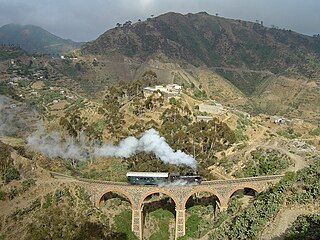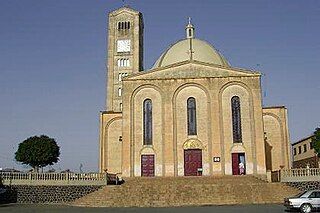
Asmara, or Asmera, is the capital and most populous city of Eritrea, in the country's Central Region. It sits at an elevation of 2,325 metres (7,628 ft), making it the sixth highest capital in the world by altitude and the second highest capital in Africa. The city is located at the tip of an escarpment that is both the northwestern edge of the Eritrean Highlands and the Great Rift Valley in neighbouring Ethiopia. In 2017, the city was declared as a UNESCO World Heritage Site for its well-preserved modernist architecture. According to local traditions, the city was founded after four separate villages unified to live together peacefully after long periods of conflict. Asmara had long been overshadowed by nearby Debarwa, the residence of the Bahr Negash or the governor of the coastal province, however it still existed as a major settlement for over half a millennium and enjoyed some importance as it stood on the trade route to Massawa. Asmara first rose to prominence during the 20th century, when it became capital of Italian Eritrea. Under Italian rule the city of Asmara experienced rapid urbanization and modernization.

The Eritrean Railway is the only railway system in Eritrea. It was constructed between 1887 and 1932 during the Italian Eritrea colony and connects the port of Massawa with Asmara. Originally it also connected to Bishia. The line was partly damaged by warfare in subsequent decades, but was rebuilt in the 1990s. Vintage equipment is still used on the line.

Massawa or Mitsiwa is a port city in the Northern Red Sea region of Eritrea, located on the Red Sea at the northern end of the Gulf of Zula beside the Dahlak Archipelago. It has been a historically important port for many centuries. Massawa has been ruled or occupied by a succession of polities during its history, including the Kingdom of Aksum, the Ethiopian Empire, the Ottoman Empire and the Kingdom of Italy.
The Asmara International Community School (AICS) in Asmara, Eritrea, is an independent, coeducational day school which offers an educational program to children from prekindergarten through grade 12. The school was founded in 1994 to serve the needs of the international community and other students seeking English-language education.

The Eritrean Catholic Church or Eritrean Eastern Catholic Church is a sui iuris (autonomous) Eastern Catholic church based in Eritrea. As a particular church of the Catholic Church, it is in full communion with the Holy See. It was established in 2015 when its territory was separated from the Ethiopian Catholic Church. The church is organized under a metropolitan bishop who exercises oversight of a number of suffragan dioceses. In its liturgical services, it uses the Alexandrian Rite in the Ge'ez language.

The Cinema Impero is an Art Deco-style cinema in Asmara, the capital of Eritrea. It was built in 1937 by the colonial authorities in Italian Eritrea.

The Governor's Palace is the city hall of Asmara, Eritrea. It was built during the colonial period in the city centre, in an Italian Art Deco style.
Asmara Brewery FC or Asmara Birra is an Eritrean football club based in Asmara and founded in 1944. It is linked and economically maintained by the Asmara Brewery.
Articles related to Eritrea include:
The 1913 Asmara earthquake took place outside Asmara, Eritrea on 27 February. The data as to the magnitude of the earthquake is imprecise due to the frequency and magnitude of aftershocks, but a maximum felt intensity of VI (Strong) on the Mercalli intensity scale was recorded at Asmara. The "felt" area of the earthquake extended into Northern Ethiopia as well as Kassala in Sudan. The earthquake caused significant damage in Asmara (VI), Keren (IV), Massawa (V) and Adi Ugri (V).
The 1921 Massawa earthquake took place off the coast of Massawa, Eritrea, on August 14 with a moment magnitude of 6.1 and a Mercalli intensity of VIII (Severe). The first aftershock after the initial earthquake was of similar magnitude. Significant damage was caused to the harbour at Massawa with a number of deaths reported. Aftershocks were felt as far away as Asmara and Dekemhare.

Eritrea–United States relations are bilateral relations between Eritrea and the United States.

Eritrea is a country in the Horn of Africa. Eritrea is the Italian form of the Greek name Ἐρυθραίᾱ, meaning "red [land]". With its capital at Asmara, it is bordered by Sudan in the west, Ethiopia in the south, and Djibouti in the southeast. The northeastern and eastern parts of Eritrea have an extensive coastline along the Red Sea, directly across from Saudi Arabia and Yemen. The nation has a total area of approximately 117,600 km2 (45,406 sq mi), and includes the Dahlak Archipelago and several of the Hanish Islands.

Eritrea, officially the State of Eritrea, is a country in the Horn of Africa region of Eastern Africa, with its capital and largest city being Asmara. It is bordered by Ethiopia in the south, Sudan in the west, and Djibouti in the southeast. The northeastern and eastern parts of Eritrea have an extensive coastline along the Red Sea. The nation has a total area of approximately 117,600 km2 (45,406 sq mi), and includes the Dahlak Archipelago and several of the Hanish Islands.
Football is the most popular sport in Eritrea. After being under Ethiopian control, Eritrea gained its independence in 1991 and in 1998 the country became a member of FIFA.

Italian Eritreans are Eritrean-born citizens who are fully or partially of Italian descent, whose ancestors were Italians who emigrated to Eritrea during the Italian diaspora, or Italian-born people in Eritrea.

Italian Eritrea was a colony of the Kingdom of Italy in the territory of present-day Eritrea. The first Italian establishment in the area was the purchase of Assab by the Rubattino Shipping Company in 1869, which came under government control in 1882. Occupation of Massawa in 1885 and the subsequent expansion of territory would gradually engulf the region and in 1889 the Ethiopian Empire recognized the Italian possession in the Treaty of Wuchale. In 1890 the Colony of Eritrea was officially founded.
The Italian School of Asmara was a government-operated Italian international school located in Asmara, the capital of Eritrea. The school closed in 2020.

Asmara circuit was a car race done in the main streets of Asmara, when it was a colony of the Kingdom of Italy. The Circuito was created in 1938 Italian Eritrea and was later done -with many interruptions- until 1972.

The history of cinema in Eritrea dates back to the country's colonial rule under the Kingdom of Italy. In connection with the growth of Italian cinema in the 1930s, so too did the rise of cinema occur in Asmara, Eritrea. In 1937, Asmara's Opera was converted into a dual-use theatre and cinema. By the following year, Asmara had a total of nine movie theatres.











